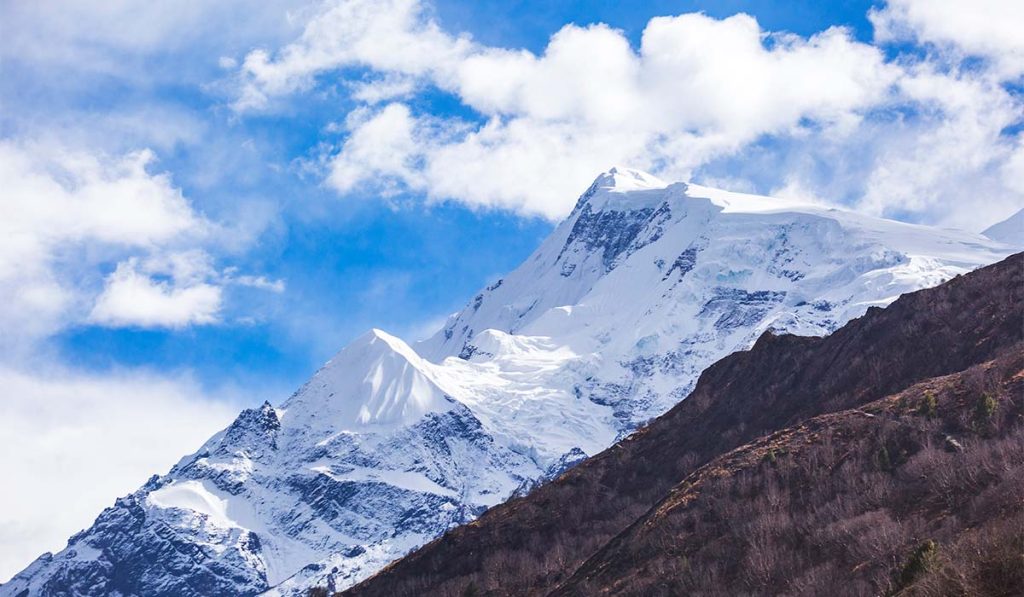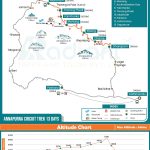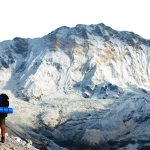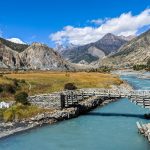The Annapurna Circuit is one of the most iconic trek routes of Nepal and choosing the right season to be here shapes your experience. While most trekkers opt for this trek in autumn, May is an underrated month for this trek. That is because the Annapurna Circuit in May has unique advantages. You are greeted with warm weather, clear mornings and vibrant landscapes in this spring month. Therefore, May is one of the best times to explore the Circuit without the heavy crowds.
Stretching 160 to 230 kilometers around the Annapurna Massif, the Circuit takes 13 days or 16 days to complete. The trail winds through lush subtropical valleys, quiet pine forests, high-altitude meadows and eventually over Thorong La Pass at 5,416 meters. Along the way, you will pass traditional Gurung and Thakali villages, Buddhist monasteries and the diverse scenery of the Himalayas.
In May, the trek feels especially alive. Rhododendrons bloom in bright red and pink, apple orchards flower near Chame, and wildlife stirs in the alpine meadows.
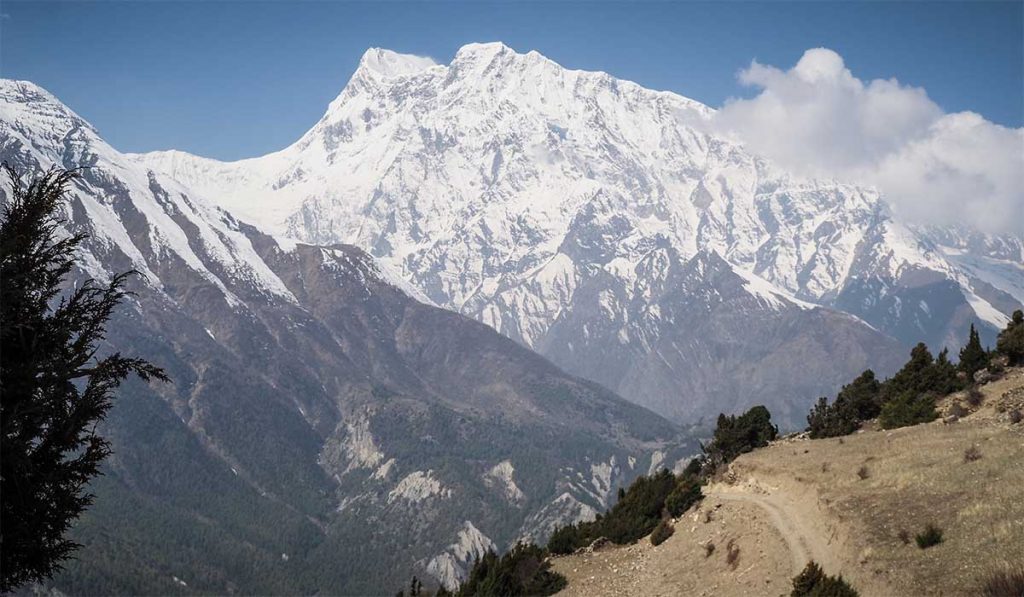
Daytime temperatures are comfortable — 15°C to 25°C in the lowlands and 5°C to 15°C at higher elevations. The nights of May are still chilly but manageable. With daylight stretching to nearly 14 hours, you’ll have more time to enjoy the trail at a relaxed pace.
Being in the Annapurna circuit in May means avoiding April’s crowds and the heavy monsoon rains of June. Though haze can blur distant views in the afternoons, mornings are usually crystal clear. They reveal giants like Annapurna I, Dhaulagiri and Machhapuchhre as you walk along the trail.
To sum it up, May isn’t just a ‘shoulder season‘, but a rewarding time to take on one of the world’s great treks.
Highlights
- Comfortable and enjoyable trekking is possible in May due to its warm days, crisp nights and long daylight hours
- Trails are adorned with rhododendrons and apple blooms as well as wildflowers
- With fewer trekkers on the route, May offers quieter paths and a relaxed, friendly atmosphere in teahouses
- Clear mornings feature breathtaking views of Annapurna, Dhaulagiri and Machhapuchhre
- The trail shifts dramatically from lush valleys and pine forests to high meadows and the arid landscapes of Mustang
- Gurung and Thakali villages, Buddhist monasteries and May’s Buddha Jayanti celebrations present a close look at local culture
- Crossing Thorong La Pass is a challenging yet rewarding experience and May’s snowmelt makes it more manageable
- Wildlife adds to the adventure, from blue sheep on the slopes to Himalayan birds and spring blossoms at higher altitudes
May Weather and Climate
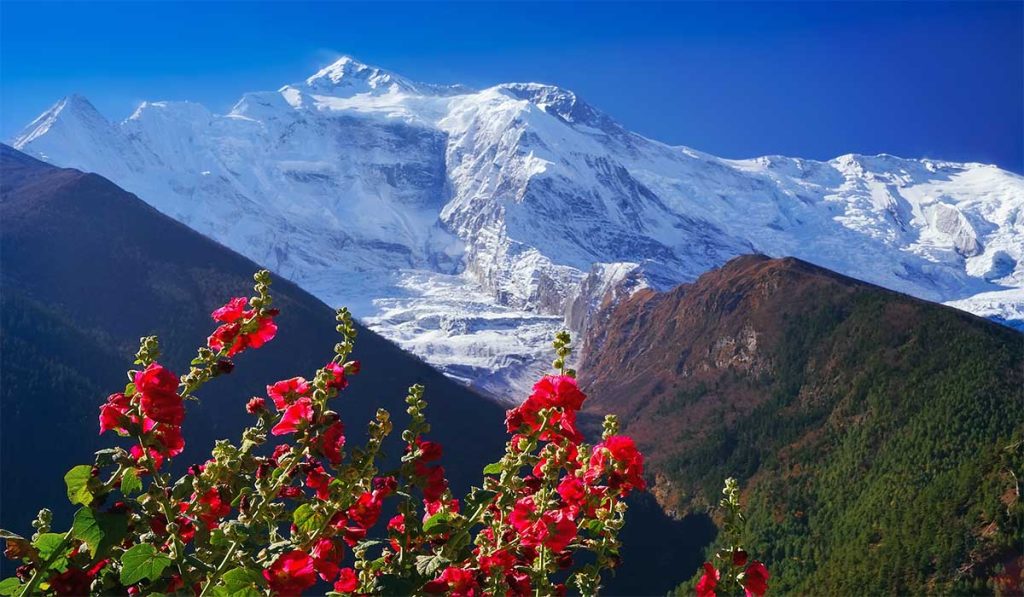
Weather can make or break a trek in the Himalayas and May strikes a near-perfect balance on the Annapurna Circuit. Spring is in full swing, the days are long and the air feels warmer in May.
Lower sections of the trail are alive with greenery and blossoms. And higher up, the snow is melting, opening passes and meadows that just weeks earlier were frozen shut.
Unlike the unpredictable monsoon months, May generally offers stability: clear mornings, mild temperatures and enough daylight to walk at an unhurried pace.
Of course, every season has its quirks and May’s mix of dust, haze, and occasional wind keeps trekkers on their toes.
Daily Temperatures
The Annapurna Circuit Trek in May feels like a gentle hug from spring. In lower elevations, such as Besisahar, daytime temperatures range between 15°C and 25°C. And this is perfect for trekking, even wearing just a T-shirt.
As you climb above 4,000 meters, expect cooler days with temperatures ranging from 5°C to 15°C. The nights are chilly as temperatures dip to 0°C to 10°C in Manang. It can even be as low as -5°C at Thorong Phedi.
The Mustang region brings stronger winds, especially in the afternoons. With 12 to 14 hours of daylight, you have ample time to soak in the scenery, though lower valleys can turn dusty. Thus, it can create a hazy glow by late afternoon.
Clear Peaks
Mornings in May are known for offering postcard-perfect views of picturesque mountains. As such, you get the best views of Annapurna I (8,091m), Dhaulagiri (8,167m) and the fishtail-shaped Machhapuchhre (6,993m).
Skies are typically clear at dawn, ideal for photography, but clouds may roll in by evening, with a 10 to 20 percent chance of light showers below 3,000 meters.
To catch the best vistas, start early. Consult weather apps or be updated on local forecasts from Pokhara to make plans.
Pack layers — a fleece and a waterproof shell — to handle sudden shifts, as the Annapurna Circuit spans over 5,000 meters of elevation.
May’s Transitional Vibes
The Circuit’s diverse climate zones shine in May. Lowlands are filled with lush greenery. Meanwhile, trails near Thorong La Pass, at high altitude, feel stark and barren.
Low humidity means fewer leeches than in summer, but pre-monsoon dust can cloud lower trails.
Preparation for May Adventure
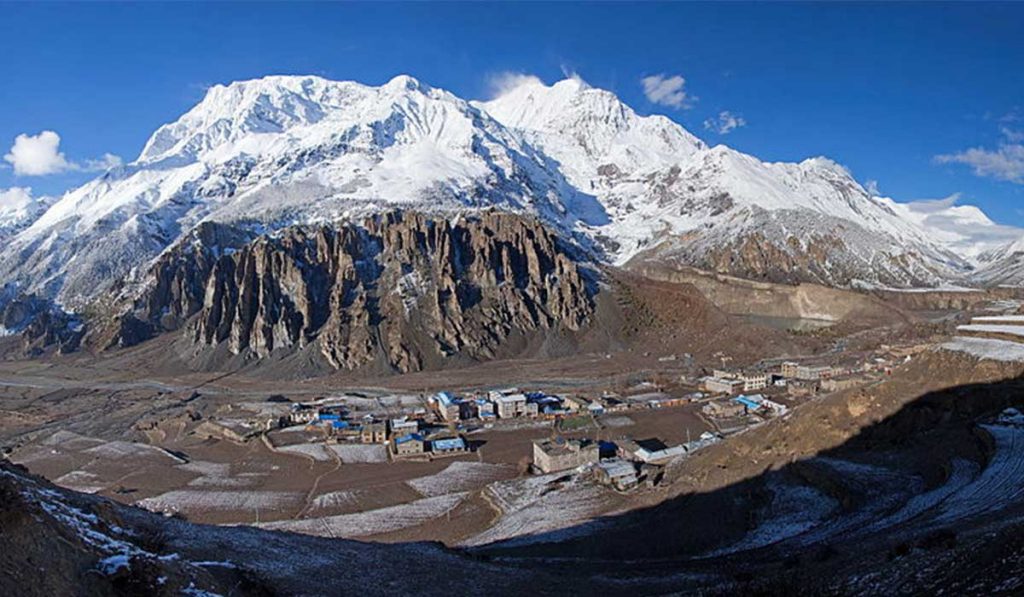
Trekking the Annapurna Circuit in May isn’t just about showing up with a backpack, it is also about preparing your body, planning your logistics and packing with the season in mind.
The trail takes you from warm valleys to cold mountain passes. Thus, a bit of groundwork before you leave makes the experience far more enjoyable. Preparation is essential for a safe and rewarding journey as it means building stamina for long days, sorting out permits and guides or choosing the right clothes.
Building Resilience
Trekking the Annapurna Circuit demands stamina, especially with May’s warming trails. Start training 4 to 6 weeks in advance. You need to hike with a 10 kg to 15 kg pack, climb stairs or hit the treadmill on an incline.
The route’s 5,416-meter peak at Thorong La requires solid acclimatization. Spend an extra day in Manang at an elevation of 3,540 meters to adjust, as May’s snowmelt can make high trails slick but easier to navigate.
Altitude sickness is a risk year-round, so hydrate with 4L of water per day and consider consulting a doctor about using Diamox for prevention.
Permits, Logistics, Booking
You’ll need one permit for the Annapurna Circuit Trek in May. It can be easily arranged in Kathmandu or Pokhara. From Kathmandu, drive for 6 to 7 hours to Pokhara, then take a bus or jeep to Dharapani to start.
Likewise, May sees a reduced number of trekkers than in April. So, booking guides or porters is simpler. But you should plan via agencies. You can contact Radiant Treks for your adventure of the Annapurna Circuit May trek.
Essential Gear
May’s mild weather calls for smart layering in terms of clothing. For that, consider packing the following items.
Clothing
- Pack a breathable merino wool base layer, a fleece for chilly mornings and a waterproof shell for rare May showers
- Bring lightweight trekking pants and moisture-wicking T-shirts for warm valley days
- Add a warm hat, gloves and a buff or scarf to protect against wind and dust in May
- Carry extra pairs of trekking socks to keep your feet dry and comfortable
Footwear
- Wear sturdy and broken-in trekking boots as they are useful when walking in dust and wet patches that are occasionally seen in May
- Carry lightweight camp shoes or sandals to give your feet a break in the evenings
- Use gaiters if you expect dusty or muddy trails during snowmelt sections
Sleeping and Comfort
- Carry a sleeping bag rated to 0°C for cold nights at higher altitudes
- Bring a lightweight sleeping bag liner for warmth as well as for hygiene in teahouses
Sun and Weather Protection
- Bring strong sun protection — SPF 50+ sunscreen, sunglasses with UV protection, and a wide-brimmed hat for long daylight hours
- Keep lip balm with SPF handy in order to prevent cracked lips
Trekking Gear
- Use trekking poles for balance on windy ridges and slippery rhododendron trails
- Carry a dust mask or buff for hazy valleys in the afternoons
- Pack a waterproof backpack cover to shield your gear from unexpected showers
Health and Safety
- Carry a first-aid kit comprising altitude medication, blister care and antihistamines for dust allergies
- Use a water purifier or purification tablets to refill from local streams and taps
- Stay hydrated by bringing a 2L water bladder or reusable bottles
- Keep insect repellent to ward off the occasional bug at lower elevations
Tech and Essentials
- Bring a headlamp with spare batteries when you are starting the trek early and in teahouses with limited power
- Carry a power bank since charging in remote areas can be costly or unavailable
- Download offline maps (Maps.me or Gaia GPS) to stay on track even without signal
- Keep cash in Nepali rupees, as most teahouses don’t accept cards
Annapurna Circuit in May: Route Overview
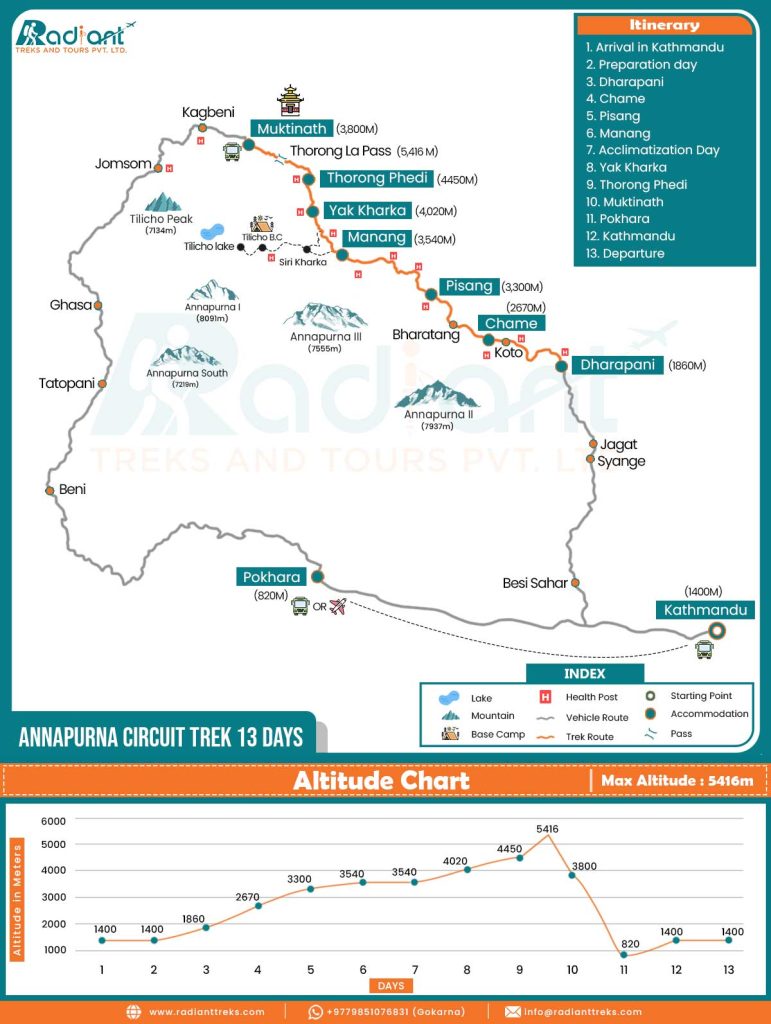
The Annapurna Circuit is a journey through Nepal’s heart, from steamy lowlands to wind-scoured passes. In May, the trail comes alive with blooming flowers, warm days and quieter paths.
Here’s how the route unfolds, broken into four key stages. And it is tailored according to the 13 Day Annapurna Circuit Trek.
Warm Valleys and the Marsyangdi River Path
This includes a journey from Kathmandu to Dharapani. As such, you traverse from an elevation of 1,400 meters to 1,860 meters.
Your adventure begins with a 7 to 8 hour drive from Kathmandu to Dharapani covering 393.4 km.
The road passes through bustling towns and into the Marsyangdi Valley. During this journey, the warmth of May paints terraced rice fields green. From Besisahar (760m), jeep tracks give way to footpaths alongside the rushing Marsyangdi River. Gurung villages dot the trail, their stone houses framed by blooming wildflower gardens.
May’s extended daylight lets you linger at riverside stops, where shallow pools invite a quick dip to cool off. Afternoon haze can blur distant peaks, so focus on the vibrant foreground — think banana trees and kids waving from bamboo bridges.
Rhododendron Forests and Pine Trails
This section of the route begins in Dharapani and ends at Manang at an elevation of 3,540 meters
From Dharapani, the trail climbs through dense pine and rhododendron forests, a highlight of May trekking. The stretch to Chame, which rests at an altitude of 2,670 meters, winds past waterfalls and hot springs, where you can soak sore muscles under blooming apple orchards.
The air feels crisp, with daytime temperatures of 10°C to 20°C if you opt for the Annapurna Circuit Trek in May. By Pisang, at the height of 3,300 meters, the forest opens to sweeping views of Annapurna II, glowing under May’s clear mornings.
Likewise, rhododendrons explode in pink and red, especially between Chame and Pisang. They turn trails into a painter’s palette. Reaching Manang means you are in a cultural hub with ancient stupas and terraced fields in view.
The mild weather of the Annapurna Circuit in May makes side hikes perfect for acclimatization. You can hike to Praken Gompa or Tilicho Lake for this purpose.
Meanwhile, teahouses buzz with stories, and the slower pace lets you chat with locals prepping for planting season in May.
High Alpine Ascents
Leaving Manang, the trail ascends into alpine terrain, from yak pastures to Thorong Phedi on the third stage of this journey. And May’s thawing snow reveals open meadows during your trek.
The climb to Yak Kharka, which is at an altitude of 4,020 meters, passes grazing yaks and wild herbs, with Gangapurna’s snowy face looming before you. The air thins, and temperatures drop to 5°C to15°C in May. But clear mornings of this spring month offer unobstructed peak views.
By the time you reach Thorong Phedi, at an elevation of 4,450 meters, you are on rocky switchbacks flanked by scree slopes. May’s snowmelt eases footing compared to winter, but stay alert for loose stones, as landslides are a slight risk.
Spot blue sheep darting across hills and breathe in the scent of alpine flora. High camps feel intimate in May, with fewer trekkers crowding the teahouses.
Thorong La Crossing and Descent
The trek’s climax is Thorong La Pass at an elevation of 5,416 meters. You need to start the trek to this destination from Thorong Phedi before dawn to catch May’s alpenglow on the peaks. The ascent is steep and rocky, but stable winds and minimal snow make it manageable.
At the pass, prayer flags flutter against a 360° panorama — Annapurna, Dhaulagiri and endless ridges. The descent to Muktinath at an elevation of 3,800 meters shifts to arid Mustang, where May’s winds whip through barren plateaus. Visit Muktinath’s sacred temple, which comes alive with pilgrims during May’s Buddha Jayanti if timed right.
From here, drive to Pokhara via Marpha, featuring apple brandy stalls and hot springs of Tatopani. Likewise, the Kali Gandaki Gorge, the world’s deepest, frames your journey with stark cliffs.
May’s warmer lowlands with temperatures 20°C to 25 °C contrast the high pass’s chill, though haze may soften views near Pokhara.
May Trek Experiences
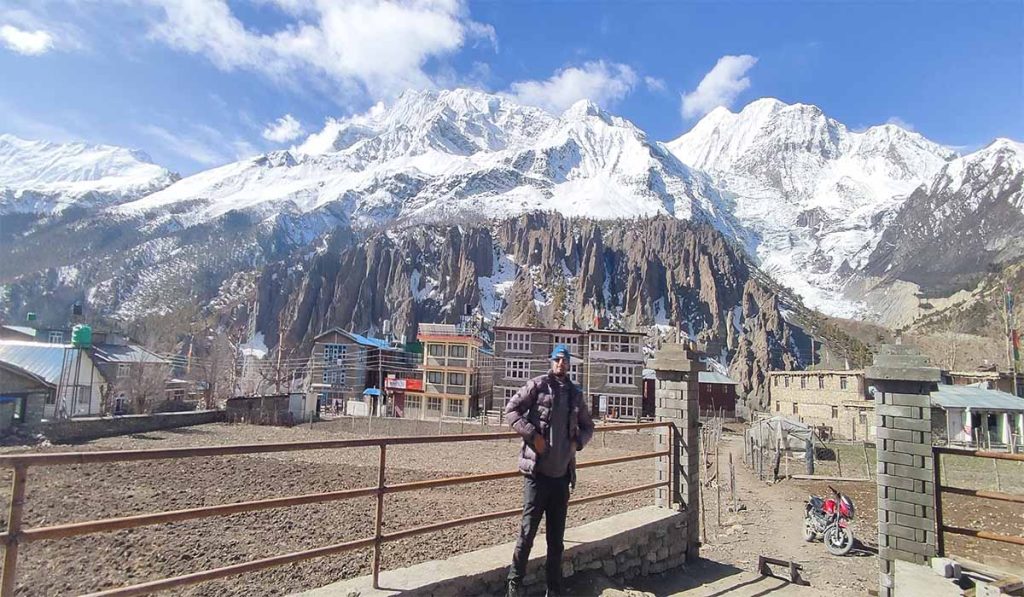
Trekking the Annapurna Circuit in May is more than hiking along diverse terrain. It is a full-on immersion for all your senses. From the colorful landscape to the warmth of local encounters and the thrill of conquering epic views, this month is filled with moments that stick with you long after the trek ends.
Here’s a closer look at what makes it special.
Rhododendron Blooms
If you reach the Annapurna Circuit in May, you feel like you have reached a botanical wonderland. Between Chame and Pisang, Nepal’s national flower, the rhododendron, blankets hills in vibrant pink and red. These blooms, set against snowy peaks, are a photographer’s dream. Shoot during golden hour, that is, from early morning or late afternoon, to capture their glow without haze. Likewise, trails near Manang also feature wildflowers and attract butterflies. All these elements add value and life to your hike.
Cultural Immersions
The Circuit is as much about people as peaks. You can see Gurung and Thakali villages active with pre-monsoon energy. Similarly, their markets are seen selling fresh veggies and handmade crafts.
In Muktinath, Buddha Jayanti brings prayer flags and chanting to the temple, if you happen to be there in the middle of May. As such, you can see a blend of Hindu and Buddhist traditions.
Likewise, teahouses serve steaming thukpa and dal bhat. The meal is often paired with Marpha’s famous apple pie. Look forward to spending quiet evenings with locals and exchanging stories over yak-butter tea due to fewer trekkers on the trail and in the teahouses.
Peaks, Passes and Personal Triumphs
May’s clear mornings frame jaw-dropping views: Dhaulagiri’s ‘White Mountain’ from Yak Kharka, Annapurna I towering over Pisang, and Thorong La’s sweeping vista. The pass itself is a personal victory; it’s thin air and a steep climb, testing your grit.
May’s quirks add flavor — Mustang’s windy trails feel wild and remote, while blue sheep and Himalayan griffons dot the high routes. Lower down, you might spot langur monkeys swinging through blooming forests. Every step feels like a story you’ll tell for years.
Practical Tips and Safety
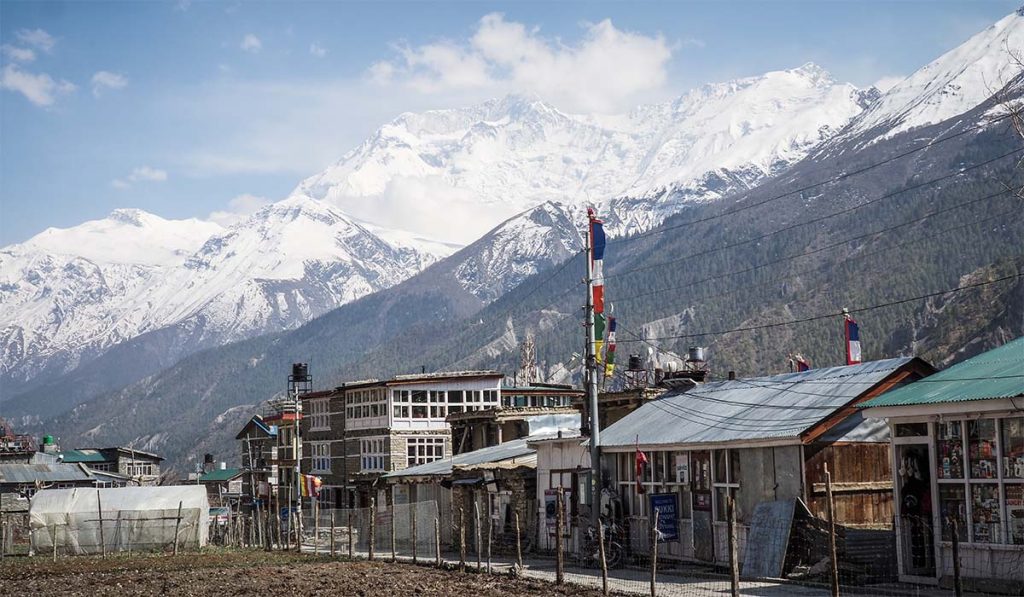
No trek is complete without some solid steps that can make your trek smooth and safe. This is true even for the Annapurna Circuit trek because of the May’s shifting weather and blooming trails that add their own twists to your journey
Whether you’re dodging dusty valleys or pacing your ascent, these tips cover the essentials — from staying on path and respecting the environment to handling health hiccups and stretching your budget.
Let’s break it down so you can focus on the adventure, not the worries.
Take Ethical Steps
Stick to marked trails during the trek. You can refer to offline apps like Maps.me to mark the route, as it may be obscured by the melting snow of May.
Likewise, follow the principle of ‘Leave No Trace’. Some of the steps in doing so are packing out trash, avoiding picking flowers and using refillable water bottles with purifiers to cut plastic waste.
Similarly, choose family-run teahouses to support locals. Many locals rely on spring trekkers for their livelihood in this region.
You should also consult your guides to understand the cultural norms of the area. They include circling stupas clockwise to show respect for the values.
Health and Contingencies
Altitude sickness is a real risk above an altitude of 3,000 meters. So, drink 4L of water daily, ascend slowly and rest in Manang. They are some ways to ward off the risk of being affected by altitude.
Meanwhile, May’s warmth reduces dehydration but can trigger allergies from valley dust. Therefore, pack antihistamines as they are lifesavers.
For emergencies, opt for satellite communication and you can coordinate with your guide for the same.
Helicopter evacuation is another option, but it can be costly. So, ensure your insurance covers trekking above 5,000 meters.
Here’s a quick safety checklist.
- Annapurna Conservation Area Permit
- An insurance policy that covers high-altitude evacuation and medical emergencies.
- Gear, including a first-aid kit, a water purifier and a headlamp
Budget and Customization
Expect USD 30 to 50 per day for solo trekking (food, teahouse lodging). Guided trips, like the one offered by Radiant Treks, simplify logistics.
Short on time? Jeep shortcuts from Besisahar can reduce your trekking days and you need not sacrifice the journey’s highlights, too. Book through Radiant Treks for deals and carry NPR for small purchases — teahouses rarely take cards.
Final Thoughts
Trekking the Annapurna Circuit in May is like stepping into a springtime dream in the Himalayas. That is so because of the rhododendrons’ blooms, warmer days and quiet paths.
From the Marsyangdi’s lush valleys to Thorong La’s stark summit, every moment feels alive with color and wonder in May.
Plan your trek now with us. Contact Radiant Treks, understand the logistics, pack your layers and hit the trail. If you are seeking a journey where spring’s warmth meets mountain grandeur, May is your perfect window.
FAQs (Frequently Asked Questions)
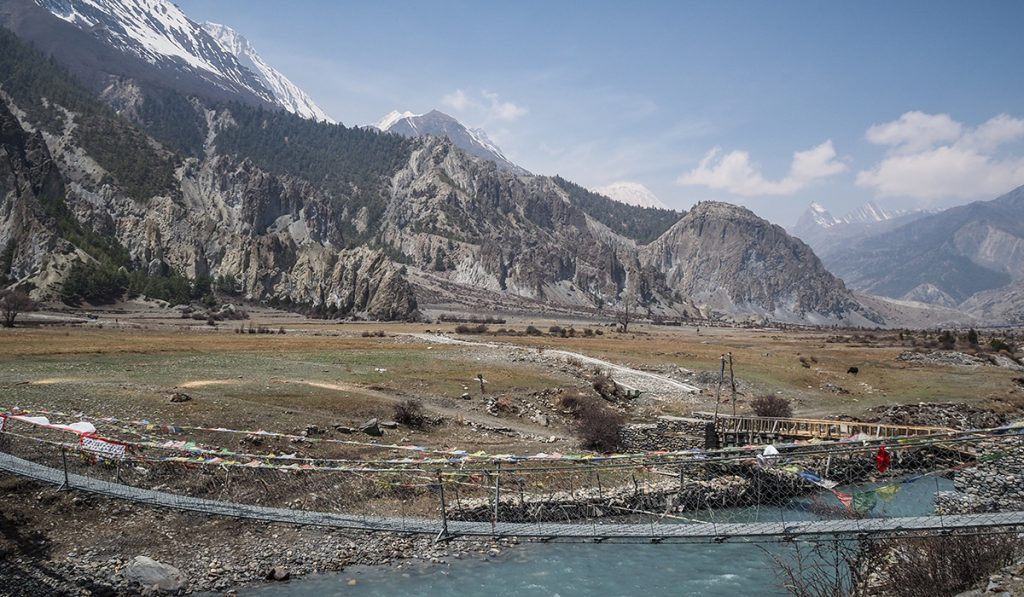
Is May a good time to trek the Annapurna Circuit?
Yes. May is one of the best months — it features warm weather, blooming rhododendrons, long daylight hours and fewer crowds than April or autumn.
How long does the Annapurna Circuit Trek in May take?
The trek usually takes 13 to 16 days, depending on your pace, acclimatization days and whether you want to do side hikes.
What kind of weather can I expect in May?
In lower regions, daytime temperatures are 15°C to 25°C, while higher up they range from 5°C to 15°C. Nights can drop close to freezing near Thorong La Pass among other places.
Are the mountain views clear in May?
Mornings are usually very clear. As such, they offer excellent views of Annapurna, Dhaulagiri and Machhapuchhre. Afternoons may bring some haze or light showers.
What should I pack for the Annapurna Circuit May trek?
Pack light layers, a fleece, a waterproof shell, sturdy boots, trekking poles, sun protection and a winter rated sleeping bag.
Is altitude sickness a risk in May?
Definitely. The highest point, Thorong La Pass, carries risk year-round. Acclimatize in Manang, drink plenty of water and pace yourself.
Are teahouses open in May?
Yes. Teahouses along the route are open, and with fewer trekkers than in April, you’ll have a good chance of finding rooms without pre-booking.
How crowded are the trails in May?
Much quieter than in April or October. You’ll still meet fellow trekkers, but the paths and teahouses feel more relaxed.

